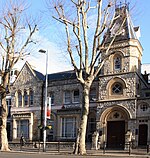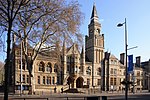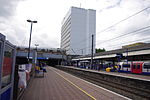Ealing Common
1733 establishments in EnglandCommon land in LondonCricket grounds in MiddlesexCricket in MiddlesexDefunct cricket grounds in England ... and 9 more
Defunct sports venues in LondonDistricts of the London Borough of EalingEnglish cricket venues in the 18th centuryHistory of MiddlesexMiddlesexParks and open spaces in the London Borough of EalingSport in LondonSports venues completed in 1733Sports venues in London

Ealing Common is a large open space (approx 47 acres or 19 hectares) in Ealing, West London.
Excerpt from the Wikipedia article Ealing Common (License: CC BY-SA 3.0, Authors, Images).Ealing Common
Warwick Road, London Acton (London Borough of Ealing)
Geographical coordinates (GPS) Address Nearby Places Show on map
Geographical coordinates (GPS)
| Latitude | Longitude |
|---|---|
| N 51.51 ° | E -0.294 ° |
Address
Warwick Road
Warwick Road
W5 3JG London, Acton (London Borough of Ealing)
England, United Kingdom
Open on Google Maps










